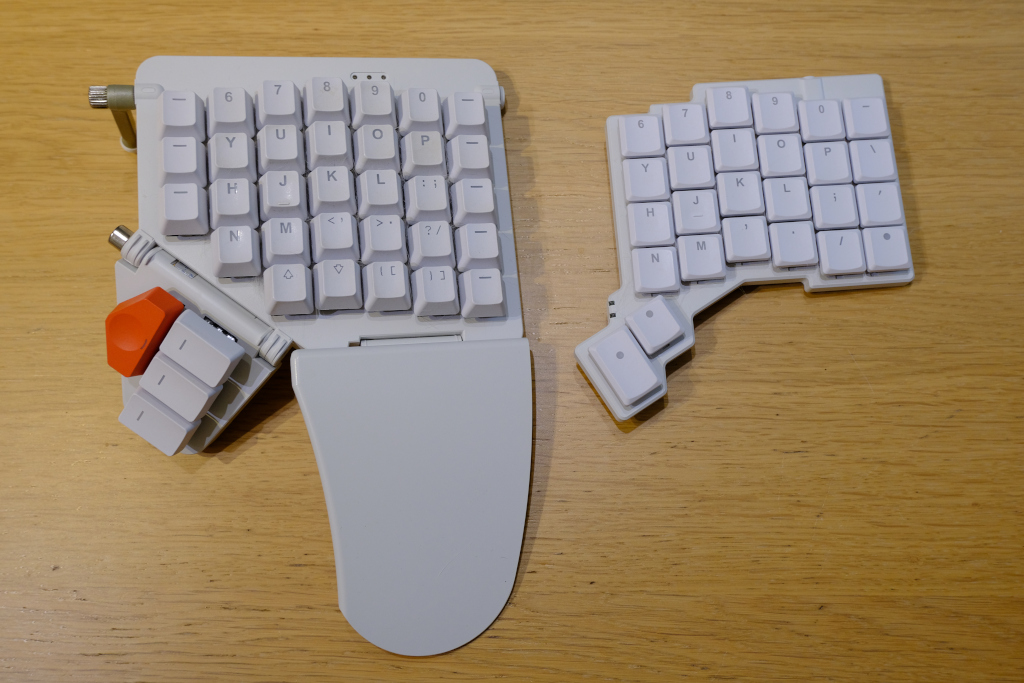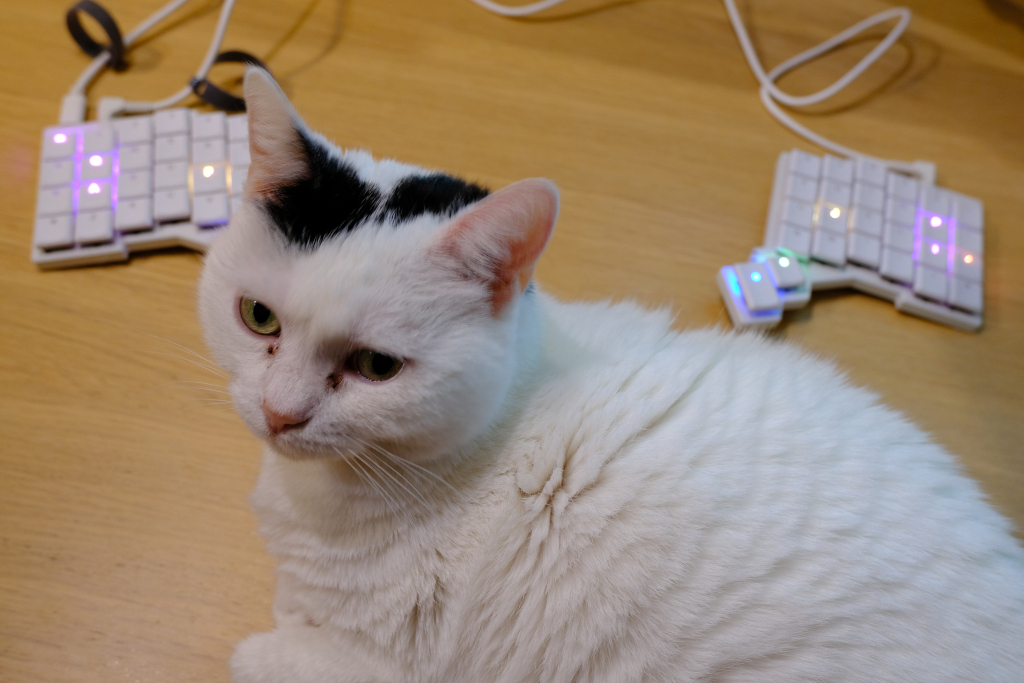Keyboard love: the ZSA voyager
Serge Hänni, 27.10.2023
Two years ago I got the ZSA Moonlander keyboard. It was my first split keyboard, as well as mechanical keyboard. The split layout was amazing for my cat (no awkward arm positions anymore trying to get passed the cat). It also massively improved typing ergonomics for me. A normal keyboard always felt wrong, as the hands need to be very close together, thus it is getting uncomfortable for the shoulders, arms and wrists. With a split keyboard, you move the keyboard halves into a position which feels comfortable and does not apply any stress.
However, I always loved low-profile keyboards. As I type a lot during work, my goal is to reduce the amount of force and movement of my fingers, to decrease wear and fatigue symptoms. With the Moonlander I always had the feeling that the vertical movement of the keys is too large.
Luckily, two years later, the ZSA Voyager is available. It is very similar to the Moonlander, but is more compact and the keys are low-profile.

TLDR
-
The Voyager is very compact and thus quite portable.
-
The quality and feel of the keyboard is really good.
-
Because it is smaller than the Moonlander, there are actually less keys.
Portability
Although the Moonlander was advertised to be portable, it was quite some work. You need to loosen a couple of screws to make it flat and even then its base is quite large, and its height is quite substantial.
The Voyager changed a lot in this regard. The keyboard feet are magnetic and can quickly be detached. In the case you get with the keyboard, there is a small metal plate, to which the keyboard feet can be attached to. Dettach the cable and you are good to go.
This is way more comfortable to take with you and your laptop, compared to the Moonlander.

Quality
The ZSA keyboards cost quite a lot. Their quality matches the price though. The Voyager has a metal backplate and the keyboard feet are sturdy. The feet are magnetically attached to the keyboard and click into place - so no lose feet anymore as with the Moonlander where the rubber feet were taped to the keyboard.
The keys feel good and there are more keycaps in the package if you want to switch some. Most notable, there are various keycaps with ridges included (usually found on the F and J keys to find those keys without looking at the keyboard), useful for people writing in Dvorak or other layouts. The switches on the Voyager are Kailh switches, which can be easily replaced.
The ZSA support is as you wish every support to be, but almost none are. A small professional team you can email with, without any ticket numbers or standard or unhelpful answers. They were always quick, helpful and very friendly.
The quality continues with the keyboard connections. There are two cables required for the keyboard: a USB-C cable to connect it to the computer and a TRRS cable (a pretty standard audio cable) to connect both keyboard halves. These are standard cables, so when one brakes, you can get a new one from anywhere.
The firmware the keyboard uses is open-source and another standard in the mechanical keyboard world: QMK. This also means that even if ZSA is not around anymore, you can still use your keyboard and keep flashing it.
Basically, there are not that many surprises comparing the ZSA keyboards to DIY builds of mechanical keyboards. With the difference that it will be very hard to get the same build quality unless you are an absolute expert.
Key layout
Compared to the Moonlander, the Voyager has less keys. You might need to adapt your layout a bit. Most notably, there is one less bottom row and one less thumb key.
As the Voyager is more compact, the thumb keys are a bit closer to the keyboard than on the Moonlander (where there was a hinge between the keyboard and the thumb cluster). In the beginning you obviously will miss those keys, but later you are quicker as your thumb does not need to move that much.
Switches
The Kailh red linear switches sound more clicky. Their sound is higher pitched, but quieter than the ones I have on the Moonlander. First, I had the feeling that I had to apply more pressure on the Voyager switches. This might be a misconception though, as I subjectively had a wrong impression about required force on the Moonlander as well (compared back then with an Apple keyboard, which actually had a higher activation force than the Moonlander, even though it felt vice-versa).
Mounts
The angle on the Voyager cannot be changed (as is possible on the Moonlander). However, there is an additional magnetic mount available for purchase, which you can then use to mount to a standard tripod, or even screw it into a plywood. That definitely needs some trial and error, until you get a setup which is comfortable for you.
Typing game
Is it cat friendly?
As with any split keyboard, definitely! As its height is quite limited, it is a bit easier for cats to rest their head on the keyboard. So you might want to move the keyboard out of the way before they get comfortable. 😺

Moonlander vs Voyager
I love the flat feeling of low-profile keys. Higher keycaps usually have larger gaps between keys, which makes the perceived distance between keys larger and obviously you feel the ridges between keys.
Overall, the Voyager meets my needs better than the Moonlander. It does have less keys, but that is easily compensated with different layers.
Only for gaming you notice the lack of the bottom row of keys.